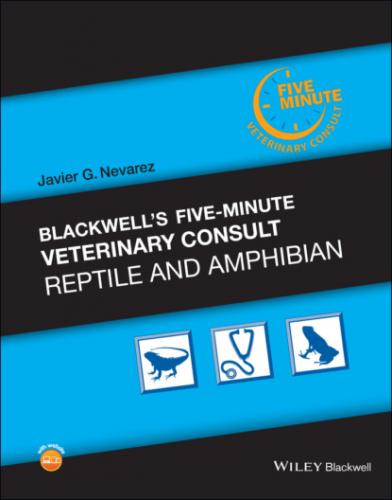PRECAUTIONS/INTERACTIONS
Hepatotoxicity and CNS toxicity have occasionally been reported in other species following metronidazole use, so care should be taken if pre‐existing hepatic dysfunction is suspected.
PATIENT MONITORING
Response to therapy is usually monitored by a reduction in clinical signs (e.g., improved appetite).
Repeat blood samples can also be taken to recheck renal parameters.
EXPECTED COURSE AND PROGNOSIS
The prognosis for patients with extensive biliary or renal damage is poor, but if diagnosed early the condition can be managed successfully.
If left untreated, the disease will slowly progress to renal failure and death.
COMMENTS
N/A
ZOONOTIC POTENTIAL
N/A
SYNONYMS
N/A
ABBREVIATIONS
CNS = central nervous system
PO = per oram
INTERNET RESOURCES
Veterinary Information Network: www.vin.com
Suggested Reading
1 Johns JD. Urogenital system. In: Girling SJ, Raiti P, eds. BSAVA Manual of Reptiles, 2nd ed. Quedgeley, UK: BSAVA; 2004:261–272.
2 Zwart P, Truyens EHA. Hexamitiasis in tortoises. Vet Parasitol 1975;1(2):175–183.
Author Joanna Hedley, BVM&S, DZooMed (Reptilian), DECZM (Herpetology), MRCVS
Hyperglycemia
DEFINITION/OVERVIEW
Hyperglycemia is abnormally high blood glucose concentration. In most species, glucose concentrations fluctuate. Normal glucose concentration ranges from 60 mg/dl to 200 mg/dl (3.3–11 mmol/l).
ETIOLOGY/PATHOPHYSIOLOGY
The etiology is largely unknown
Transient hyperglycemia may be postprandial or stress induced.
Elevated glucose may be seen during ovulation, and in certain neoplastic conditions.
Iatrogenic from prior glucose or glucocorticosteroid administration.
Hyperglycemia has been documented in parasitic pancreatitis (Serpinema microcephalus).
It is speculated that endocrine pancreas disease may lead to insulin deficiency resulting in a diabetes mellitus‐like syndrome, but this has not been documented.
SIGNALMENT/HISTORY
N/A
CLINICAL PRESENTATION
Unspecific
Possibly increased water consumption, increased urine (urate) production, and weight loss.
RISK FACTORS
Husbandry
Largely unknown
Stress from handling or improper housing may predispose.
Others
N/A
Blood glucose levels above 200 mg/dl (11 mmol/l) indicate hyperglycemia.
DIFFERENTIAL DIAGNOSIS
N/A
DIAGNOSTICS
Blood glucose measurements should be repeated, as a single elevated value is likely insignificant.
Persistent hyperglycemia is a more relevant finding.
Glucosuria should be evaluated to identify chronic hyperglycemia.
Underlying causes should be investigated: ovarian activity, neoplasia (particularly stomach and pancreas), metabolic disease.
PATHOLOGICAL FINDINGS
The etiology for persistent hyperglycemia is unknown, but endocrine pancreas should be thoroughly evaluated.
APPROPRIATE HEALTH CARE
N/A
NUTRITIONAL SUPPORT
N/A
CLIENT EDUCATION/HUSBANDRY RECOMMENDATIONS
N/A
DRUG(S) OF CHOICE
In cases with persistent hyperglycemia, where systemic disease has been ruled out, experimental insulin treatment may be attempted.
Suggested starting dose: 1–5 iu q24–48h.
PRECAUTIONS/INTERACTIONS
N/A
PATIENT MONITORING
Follow up with repeated glucose measurements, and monitor general health of patient.
EXPECTED COURSE
